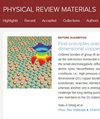Length and torsion dependence of thermal conductivity in twisted graphene nanoribbons
IF 3.4
3区 材料科学
Q2 MATERIALS SCIENCE, MULTIDISCIPLINARY
引用次数: 0
Abstract
Research on the physical properties of materials at the nanoscale is crucial for the development of breakthrough nanotechnologies. One of the key properties to consider is the ability to conduct heat, i.e., its thermal conductivity. Graphene is a remarkable nanostructure with exceptional physical properties, including one of the highest thermal conductivities (TCs) ever measured. Graphene nanoribbons (GNRs) share most fundamental properties with graphene, with the added benefit of having a controllable electronic bandgap. One method to achieve such control is by twisting the GNR, which can tailor its electronic properties, as well as change their TCs. Here, we revisit the dependence of the TC of twisted GNRs (TGNRs) on the number of applied turns to the GNR by calculating more precise and mathematically well defined geometric parameters related to the TGNR shape, namely, its twist and writhe. We show that the dependence of the TC on twist is not a simple function of the number of turns initially applied to a straight GNR. In fact, we show that the TC of TGNRs requires at least two parameters to be properly described. Our conclusions are supported by atomistic molecular dynamics simulations to obtain the TC of suspended TGNRs prepared under different values of initially applied turns and different sizes of their suspended part. Among possible choices of parameter pairs, we show that TC can be appropriately described by the initial number of turns and the initial twist density of the TGNRs.

扭曲石墨烯纳米带热导率的长度和扭转依赖性
研究纳米级材料的物理特性对于开发突破性纳米技术至关重要。需要考虑的关键特性之一是导热能力,即热导率。石墨烯是一种非凡的纳米结构,具有卓越的物理特性,包括迄今测量到的最高导热系数(TC)之一。石墨烯纳米带(GNR)与石墨烯具有相同的基本特性,但更多的优点是具有可控的电子带隙。实现这种控制的方法之一是扭转 GNR,扭转 GNR 可以调整其电子特性,并改变其 TC。在此,我们通过计算与 TGNR 形状相关的更精确、数学定义更明确的几何参数,即扭转和扭曲,重新探讨了扭转 GNR(TGNR)的 TC 与 GNR 旋转圈数的关系。我们的研究表明,TC 对扭转的依赖性并不是最初应用于直线 GNR 的转数的简单函数。事实上,我们表明 TGNR 的 TC 至少需要两个参数才能正确描述。原子分子动力学模拟支持了我们的结论,模拟获得了悬浮 TGNR 在不同初始转数值和不同悬浮部分尺寸条件下的 TC 值。在可能选择的参数对中,我们发现 TC 可以通过 TGNR 的初始转数和初始扭曲密度得到适当的描述。
本文章由计算机程序翻译,如有差异,请以英文原文为准。
求助全文
约1分钟内获得全文
求助全文
来源期刊

Physical Review Materials
Physics and Astronomy-Physics and Astronomy (miscellaneous)
CiteScore
5.80
自引率
5.90%
发文量
611
期刊介绍:
Physical Review Materials is a new broad-scope international journal for the multidisciplinary community engaged in research on materials. It is intended to fill a gap in the family of existing Physical Review journals that publish materials research. This field has grown rapidly in recent years and is increasingly being carried out in a way that transcends conventional subject boundaries. The journal was created to provide a common publication and reference source to the expanding community of physicists, materials scientists, chemists, engineers, and researchers in related disciplines that carry out high-quality original research in materials. It will share the same commitment to the high quality expected of all APS publications.
 求助内容:
求助内容: 应助结果提醒方式:
应助结果提醒方式:


